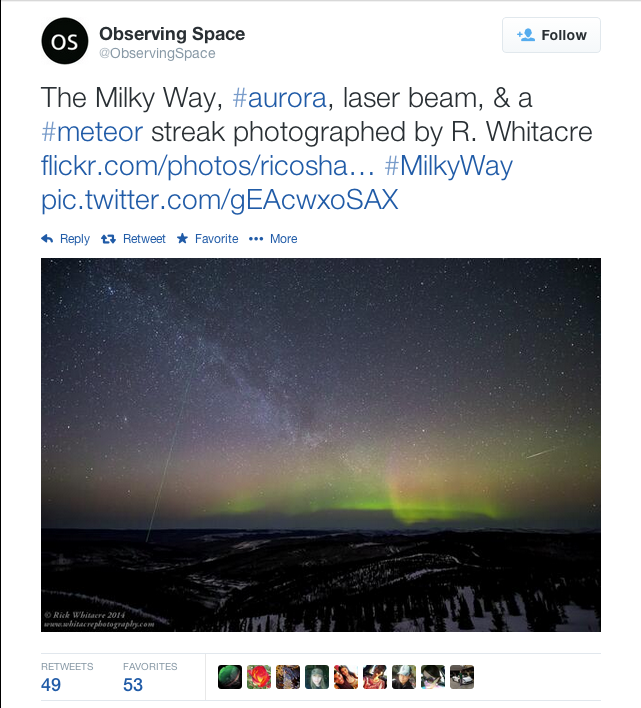Happy Summer Solstice!
Sat 2014-06-21 10:51:00 +0000
Sat 2014-06-21 06:51:00 -0400
Happy Summer Solstice!
Sat 2014-06-21 10:51:00 +0000
Sat 2014-06-21 06:51:00 -0400

It’s now been eight months since I switched to the iPhone in October 2012. The honeymoon is over and I’ve been chewing on the green grass for a while. I can say I’m just as happy and pleased with the the 5C as I was when it was new, maybe even more.
It does everything I need or want it to do. I have a nice set of apps I use daily, a simulation and a game here or there, and generally I can find just about anything I need in an app and it all works fine.
I’m still using the Gmail and the Google Maps apps for email, maps and navigation. Amazon cloud player was just updated and is still my primary music player. Netflix works fine but I typically use the Youtube app for watching videos.
Apple’s iMessage works great for texting with images and video with the rest of the family and we all have iPhones at this point.
The camera continues to make great pictures, as expected.
Here are some of the most recent apps of significance I’ve added. Loom was bought by Dropbox who introduced an app called Carousel, so I’m not using it to automatically upload and archive photos. Carousel is nice as an app but there doesn’t seem to be a correspondingly nice web interface other then a plain Dropbox folder with a lot of image files in it.
I’m not a fan of Facebook. In fact I don’t like it much at all. However, I have to say that Paper is nicely done, beautiful in some ways, but a little quirky sometimes. I like it many times better than the regular Facebook interface because it’s fun to use, but I ignore the news feed and those other screens.
I’ve become interested in trains lately and Trainz Driver is a fun simulator.
If you compare the current image of my home screen here to the image I posted back in October 2012, you can see that it hasn’t changed much. That’s screen one and I only use three screens of apps that are about ½ to 2/3 full.
Image: my current iPhone screen one.

From @ObservingSpace.
I’ve been reluctantly learning some Javascript recently. While looking for a good summary of a feature comparison between Python and Javascript, I found this blog post by Matt Chisholm, A tour of the differences between JavaScript and Python.

I just watched Gravity this morning. It was very entertaining and I liked the movie.
Congratulations are due for executing the physics of objects’ motions and the look of a so-called “zero gravity” (in orbit) environment so well. It was all believable. I can’t believe they didn’t shuttle the crew up to the ISS and shoot it on site, it was realistic enough.
The behaviour of tethered objects and such were pretty real.
However, there were some technical points to complain about. Here’s a quick run down. And, yes, there are lots of spoilers here.
Image: NASA Image. S116-E-06645 (16 Dec. 2006)—Astronaut Robert L. Curbeam, Jr., STS-116 mission specialist, participates in the mission’s third planned session of extravehicular activity (EVA) as construction resumes on the International Space Station.
I think for nearly 30 years I’ve used TeX style quoting for double quotes in anything I wrote using ASCII text.
``Quoted text.''
Now that I’ve adopted Markdown for nearly anything that I enter as ASCII that’s intended to be English text (probably rich text), I’ve also, finally, decided to use the double-quote character. It’s true that the ASCII double quote doesn’t explicitly specify whether a left- or right-double quote is intended, but the implication is usually clear enough and (hopefully) rendering code is now smart enough to do the “right thing.”

For the first time since SN1987A there’s a nearby supernova and this one was apparently caught during it’s brightness increase.
Space.com
IAU Central Bureau for Astronomical
Telegrams: PSN
J09554214+6940260
Nicely written article by Meg Urry at
CNN.com
From Meg Urry’s article:
Type Ia supernovae have happened in our galactic neighborhood only three times in the last 80 years.
…
The reason Type Ia supernovae are special is their uniformity. Basically, they all explode at about the same mass, so they are all roughly equally luminous. Better understanding the physics of that explosion and the effect of local galactic environment will make Type Ia supernovae even better “standard candles” and improve our understanding of the properties of dark energy and the cosmological evolution of the universe. The more data we can get, and the closer the supernova, the better the calibration.
Discovery story from University College
London
Wikipedia article on Type Ia Supernovae
Why is this supernova J only 21 days into January, i.e, the 10th supernova so var this year? From the International Astronomical Union (IAU) here’s the list of discoveries so far.
Image credit: UCL/University of London Observatory/Steve Fossey/Ben Cooke/Guy Pollack/Matthew Wilde/Thomas Wright (CC BY 3.0)
Via @physorg_com Massive black hole duo: Possible sighting by WISE
Astronomers have spotted what appear to be two supermassive black holes at the heart of a remote galaxy, circling each other like dance partners. The incredibly rare sighting was made with the help of NASA’s Wide-field Infrared Survey Explorer, or WISE.
…
It is these close-knit black holes, also called black hole binaries, that have been the hardest to find. The objects are usually too small to be resolved even by powerful telescopes. Only a few strong candidates have been identified to date, all relatively nearby. The new WISE J233237.05-505643.5 is a new candidate, and located much farther away, at 3.8 billion light-years from Earth.
Radio images with the Australian Telescope Compact Array were key to identifying the dual nature of WISE J233237.05-505643.5. Supermassive black holes at the cores of galaxies typically shoot out pencil-straight jets, but, in this case, the jet showed a zigzag pattern. According to the scientists, a second massive black hole could, in essence, be pushing its weight around to change the shape of the other black hole’s jet.
…
“We note some caution in interpreting this mysterious system,” said Daniel Stern of JPL, a co-author of the study. “There are several extremely unusual properties to this system, from the multiple radio jets to the Gemini data, which indicate a highly perturbed disk of accreting material around the black hole, or holes. Two merging black holes, which should be a common event in the universe, would appear to be simplest explanation to explain all the current observations.”
WISE J233237.05–505643.5: A Double-peaked, Broad-lined Active Galactic Nucleus with a Spiral-shaped Radio Morphology, Chao-Wei Tsai et al. 2013 ApJ 779 41
Paper at arXiv